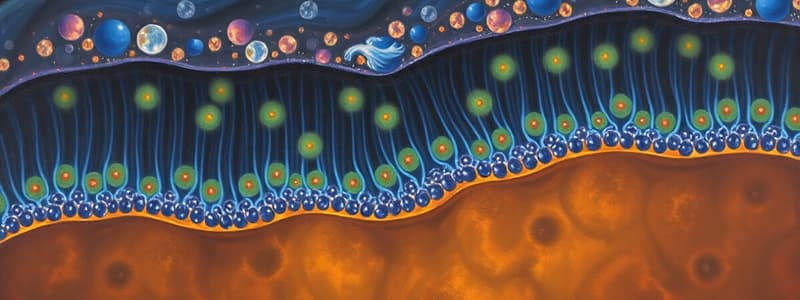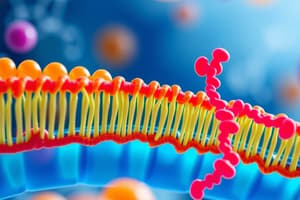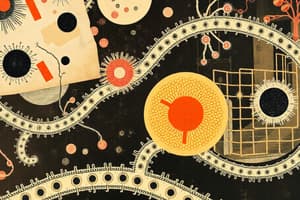Podcast
Questions and Answers
What is a requirement for filtration to occur?
What is a requirement for filtration to occur?
- A pressure gradient (correct)
- A temperature gradient
- A concentration gradient
- An electrical gradient
In active transport, what role does ATP play?
In active transport, what role does ATP play?
- ATP provides energy to move substances across the membrane (correct)
- ATP dissolves the substances for easier transport
- ATP slowly diffuses through the membrane
- ATP binds to the membrane to change its permeability
Which process would be used when substances are too large to pass through membrane channels?
Which process would be used when substances are too large to pass through membrane channels?
- Osmosis
- Facilitated diffusion
- Passive diffusion
- Active transport (correct)
What is the primary function of protein carriers known as solute pumps in active transport?
What is the primary function of protein carriers known as solute pumps in active transport?
What are the three main parts of a generalized cell?
What are the three main parts of a generalized cell?
What is the primary function of the plasma membrane?
What is the primary function of the plasma membrane?
In the fluid mosaic model of the plasma membrane, what structure is formed by phospholipids?
In the fluid mosaic model of the plasma membrane, what structure is formed by phospholipids?
What characteristic of phospholipids allows them to form the basis of cell membranes?
What characteristic of phospholipids allows them to form the basis of cell membranes?
Which of the following statements about the hydrophobic tails of the plasma membrane is correct?
Which of the following statements about the hydrophobic tails of the plasma membrane is correct?
What role do proteins play in the plasma membrane?
What role do proteins play in the plasma membrane?
What is the purpose of glycoproteins in the plasma membrane?
What is the purpose of glycoproteins in the plasma membrane?
What component is present in larger quantities in a solution?
What component is present in larger quantities in a solution?
What is the role of microvilli on cell membranes?
What is the role of microvilli on cell membranes?
Which of the following fluids is known as intracellular fluid?
Which of the following fluids is known as intracellular fluid?
What differentiates passive processes from active processes in membrane transport?
What differentiates passive processes from active processes in membrane transport?
Which statement is accurate regarding the plasma membrane's selectively permeable nature?
Which statement is accurate regarding the plasma membrane's selectively permeable nature?
What is found in extracellular fluid?
What is found in extracellular fluid?
Which of the following is not a function of the plasma membrane?
Which of the following is not a function of the plasma membrane?
What is the primary function of the nuclear envelope?
What is the primary function of the nuclear envelope?
What is the role of the nucleolus within the nucleus?
What is the role of the nucleolus within the nucleus?
What distinguishes chromatin from chromosomes?
What distinguishes chromatin from chromosomes?
What are the three major components of the cytoplasm?
What are the three major components of the cytoplasm?
What function do mitochondria primarily serve within the cell?
What function do mitochondria primarily serve within the cell?
What is the primary characteristic of inclusions in the cytoplasm?
What is the primary characteristic of inclusions in the cytoplasm?
What structural feature do mitochondria have?
What structural feature do mitochondria have?
When does chromatin condense into chromosomes?
When does chromatin condense into chromosomes?
Which process requires nuclear pores?
Which process requires nuclear pores?
Which type of cell junction is characterized as being impermeable and forms leakproof sheets?
Which type of cell junction is characterized as being impermeable and forms leakproof sheets?
What is the function of desmosomes in a cellular structure?
What is the function of desmosomes in a cellular structure?
How do gap junctions facilitate communication between cells?
How do gap junctions facilitate communication between cells?
What is the primary component of the nuclear envelope?
What is the primary component of the nuclear envelope?
What is the main role of DNA within the nucleus?
What is the main role of DNA within the nucleus?
Which of the following descriptions best fits the function of the nucleolus?
Which of the following descriptions best fits the function of the nucleolus?
What is the structural feature of cell membranes that allows adjacent cells to interlock?
What is the structural feature of cell membranes that allows adjacent cells to interlock?
What is the primary purpose of the plasma membrane in cells?
What is the primary purpose of the plasma membrane in cells?
What is the primary function of interphase in the cell cycle?
What is the primary function of interphase in the cell cycle?
During which phase of mitosis do chromosomes align at the equatorial plate?
During which phase of mitosis do chromosomes align at the equatorial plate?
Which checkpoint during the cell cycle is responsible for assessing DNA replication and repair?
Which checkpoint during the cell cycle is responsible for assessing DNA replication and repair?
What occurs during the anaphase stage of mitosis?
What occurs during the anaphase stage of mitosis?
What is the process of cytoplasmic division that follows mitosis called?
What is the process of cytoplasmic division that follows mitosis called?
Which phase of the cell cycle involves growth and synthesis of proteins and organelles?
Which phase of the cell cycle involves growth and synthesis of proteins and organelles?
What is the significance of checkpoint mechanisms in the cell cycle?
What is the significance of checkpoint mechanisms in the cell cycle?
Which of the following correctly describes prophase in mitosis?
Which of the following correctly describes prophase in mitosis?
Flashcards
Plasma Membrane
Plasma Membrane
A thin, flexible barrier that surrounds the cell, controlling what enters and exits the cell.
Fluid Mosaic Model
Fluid Mosaic Model
A model describing the structure of the plasma membrane as a constantly moving and flexible structure made up of phospholipids, cholesterol, and proteins.
Phospholipids
Phospholipids
The main component of the plasma membrane, with a hydrophilic head and a hydrophobic tail.
Hydrophilic
Hydrophilic
Signup and view all the flashcards
Hydrophobic
Hydrophobic
Signup and view all the flashcards
Glycocalyx
Glycocalyx
Signup and view all the flashcards
Glycoproteins
Glycoproteins
Signup and view all the flashcards
Cell junctions
Cell junctions
Signup and view all the flashcards
Tight junctions
Tight junctions
Signup and view all the flashcards
Desmosomes
Desmosomes
Signup and view all the flashcards
Gap junctions
Gap junctions
Signup and view all the flashcards
Nucleus
Nucleus
Signup and view all the flashcards
Nuclear envelope
Nuclear envelope
Signup and view all the flashcards
Nucleolus
Nucleolus
Signup and view all the flashcards
Chromatin
Chromatin
Signup and view all the flashcards
Nuclear Pores
Nuclear Pores
Signup and view all the flashcards
Ribosomes
Ribosomes
Signup and view all the flashcards
Chromosomes
Chromosomes
Signup and view all the flashcards
Cytoplasm
Cytoplasm
Signup and view all the flashcards
Cytosol
Cytosol
Signup and view all the flashcards
Organelles
Organelles
Signup and view all the flashcards
Facilitated Diffusion
Facilitated Diffusion
Signup and view all the flashcards
Filtration
Filtration
Signup and view all the flashcards
Active Transport
Active Transport
Signup and view all the flashcards
Why is ATP needed for active transport?
Why is ATP needed for active transport?
Signup and view all the flashcards
Vesicular Transport
Vesicular Transport
Signup and view all the flashcards
Cilia
Cilia
Signup and view all the flashcards
Flagella
Flagella
Signup and view all the flashcards
Microvilli
Microvilli
Signup and view all the flashcards
Solution
Solution
Signup and view all the flashcards
Solvent
Solvent
Signup and view all the flashcards
Solute
Solute
Signup and view all the flashcards
Intracellular fluid
Intracellular fluid
Signup and view all the flashcards
Extracellular fluid
Extracellular fluid
Signup and view all the flashcards
Selectively permeable membrane
Selectively permeable membrane
Signup and view all the flashcards
Cell Cycle
Cell Cycle
Signup and view all the flashcards
Interphase
Interphase
Signup and view all the flashcards
M Phase
M Phase
Signup and view all the flashcards
G1 Phase
G1 Phase
Signup and view all the flashcards
S Phase
S Phase
Signup and view all the flashcards
G2 Phase
G2 Phase
Signup and view all the flashcards
Mitosis
Mitosis
Signup and view all the flashcards
Prophase
Prophase
Signup and view all the flashcards
Metaphase
Metaphase
Signup and view all the flashcards
Anaphase
Anaphase
Signup and view all the flashcards
Study Notes
Cell Structure and Function
- A generalized cell has three main regions: the plasma membrane, nucleus, and cytoplasm.
The Plasma Membrane
- A transparent barrier that encloses the cell contents.
- Separates the cell contents from the surrounding environment.
- Constructed from the fluid mosaic model, which allows for selectivity of movement across the membrane.
Fluid Mosaic Model
- Two layers of phospholipids arranged tail-to-tail.
- Cholesterol and proteins scattered among the phospholipids.
- Sugar groups may be attached to the phospholipids, forming glycolipids.
- Polar heads of phospholipid molecules interact with water.
- Nonpolar tails of phospholipid molecules form the interior of the membrane, making the membrane relatively impermeable to water-soluble molecules.
- Proteins are responsible for membrane specialization: enzymes, receptors for hormones or other chemical messengers, transport via channels or carriers.
- The membrane is selectively permeable, allowing some materials to pass while excluding others.
Role of Sugars in the Plasma Membrane
- Glycoproteins are branched sugars attached to proteins just outside the cellular space.
- The glycocalyx is the fuzzy, sticky, sugar-rich area on the cell's surface, involved in cell recognition.
Cell Membrane Junctions
- Cells are joined together in three ways: glycoproteins, wavy contours, and special junctions.
- Glycoproteins in the glycocalyx act as an adhesive or cellular glue.
- Wavy contours of adjacent cell membranes fit in a tongue-and-groove fashion.
- Special cell membrane junctions, varying structurally, are formed.
Main Types of Cell Junctions
- Tight junctions
- Impermeable which prevent substances from travelling between adjacent cells.
- Plasma membranes of adjacent cells fuse like a zipper, forming an impermeable barrier.
- Desmosomes
- Anchoring junctions, like rivets that prevent cells from being pulled apart due to stress.
- Created by buttonlike thickenings of adjacent plasma membranes, connected by intermediate filaments.
- Gap junctions (communicating junctions)
- Allow communication between cells.
- Hollow cylinders of proteins (connexons) span the width of abutting membranes, forming channels.
- Molecules can travel directly from one cell to the next via the channels.
The Nucleus
- The control center of the cell.
- Contains genetic material (DNA) needed for building proteins and cell reproduction.
- Three regions:
- Nuclear envelope (membrane)
- Consists of a double membrane that encloses the nucleus.
- Contains nuclear pores that allow material exchange.
- Encloses the jellylike fluid called the nucleoplasm.
- Nucleolus
- Nucleus contains one or more dark-staining nucleoli.
- Sites of ribosome assembly, creating ribosomal subunits.
- Ribosomes migrate into the cytoplasm via nuclear pores, to serve as protein synthesis sites.
- Chromatin
- Composed of DNA wound around histones (proteins).
- Appears scattered in the nucleus when the cell is not dividing, called chromatin.
- Condenses to form chromosomes during cell division, becoming more tightly packed structures.
- Nuclear envelope (membrane)
The Cytoplasm
- The cellular material outside the nucleus and inside the plasma membrane.
- The site of most cellular activities.
- Includes cytosol, inclusions, and organelles.
Cytosol
- Fluid that suspends other elements.
- Contains nutrients and electrolytes, essential for cellular processes.
Inclusions
- Chemical substances such as stored nutrients or cell products.
- Float in the cytosol, often serving as storage areas.
Organelles
- Metabolic machinery of the cell.
- Carry out specific functions for the cell, each with specialized structures and processes.
- Many are membrane-bound, allowing compartmentalization of their functions, keeping processes segregated.
Mitochondria
- Powerhouses of the cell, performing reactions where oxygen is used to break down food into ATP molecules, the primary energy currency of the cell.
- Mitochondrial wall consists of a double membrane with cristae (folds) on the inner membrane, increasing surface area for chemical reactions.
Ribosomes
- Made of protein and ribosomal RNA.
- Sites of protein synthesis.
- Found at two locations: free in the cytoplasm, or attached to the rough endoplasmic reticulum.
Endoplasmic Reticulum (ER)
- Fluid-filled tunnels that carry substances within the cell.
- Continuous with the nuclear membrane.
- Two types:
- Rough ER: Studded with ribosomes, synthesizes proteins, and transports vesicles that move proteins within the cell. Abundant in cells making/exporting proteins.
- Smooth ER: Lacks ribosomes, involved in lipid metabolism and drug detoxification.
Golgi Apparatus
- Appears as a stack of flattened membranes associated with tiny vesicles.
- Modifies and packages proteins arriving from the rough ER, adding or altering molecules on them.
- Produces different types of packages: secretory vesicles (pathway 1), in-house proteins and lipids (pathway 2), and lysosomes (pathway 3). Vesicles transport these products to their destinations.
Lysosomes
- Membranous "bags” containing digestive enzymes.
- Digest worn-out or nonusable cell structures and foreign material.
- Contain phagocytes (cells that dispose of bacteria and cell debris).
Peroxisomes
- Membranous sacs of oxidase enzymes.
- Detoxify harmful substances (e.g., alcohol and formaldehyde).
- Break down free radicals (highly reactive chemicals) into hydrogen peroxide, then water.
- Replicate by pinching in half or budding from the ER.
Cytoskeleton
- Network of protein structures extending throughout the cytoplasm.
- Provides the cell with an internal framework, determining cell shape, supports organelles, and provides the machinery for intracellular transport.
- Three types of elements: microfilaments (largest), intermediate filaments, and microtubules (smallest), each with specific structural and functional roles.
Centrioles
- Rod-shaped bodies made of nine triplets of microtubules.
- Generate microtubules.
- Direct the formation of the mitotic spindle during cell division.
Cell Extensions
- Surface extensions found in some cells.
- Cilia- Motility (movement of materials). Located in the respiratory system.
- Flagella- Motility. The only flagellated cell in the human body is sperm cells.
- Microvilli- Increase surface area for absorption.
Membrane Transport
- Solutions: Homogenous mixtures of two or more components.
- Solvent: Dissolving medium (e.g., water).
- Solutes: Components in smaller quantities.
- Intracellular Fluid: Nucleoplasm and cytosol (solution of gases, nutrients, salts in water).
- Extracellular Fluid: Interstitial fluid (on the exterior of cells). Contains nutrients, hormones, neurotransmitters, salts, and waste products.
- Selectively Permeable Barrier: Some things can traverse the plasma membrane via passive or active methods, based on size, charge, and lipid solubility.
- Passive Processes: substances move across the membrane without cell input; relies on molecular movement due to kinetic energy. Includes diffusion (molecules move down a concentration gradient) and filtration (water and solutes pushed through the membrane due to pressure).
- Active Processes: substances move across the membrane via the input of energy (ATP). Some examples include active transport (using protein carriers aka solute pumps to move substances against their concentration gradients) and vesicular transport (bulk movement across membranes via vesicles). - Vesicular Transport: Includes: - Exocytosis: mechanism used by cells to actively secrete hormones, mucus, and products. - Docking proteins on the vesicles recognize plasma membrane proteins and bind with them. Membranes fuse together. - Endocytosis: extracellular substances enclosed in membranous vesicle. Vesicle detaches and enters the cell and sometimes fuses with a lysosome. - Types of endocytosis include:
- Phagocytosis: “Cell-eating”. Cell engulfs large particles (e.g., bacteria, dead body cells). Pseudopods used to separate the substances from their environment. Phagocytosis is a protective mechanism, not a means of getting nutrients.
- Pinocytosis: “Cell drinking”. The cell engulfs substances from extracellular fluid, including dissolved proteins or fats. Plasma membrane forms a pit and edges fuse around the droplet creating a vesicle. Routine activity for many cells, such as in absorption cells.
- Receptor-Mediated Endocytosis: A highly selective way to take in substances by using receptor proteins on the cell membrane to bind specific substances (like enzymes, hormones, cholesterol, and iron). Protein carriers are required for certain substances to move against the concentration gradient.
Cell Division
- The cell life cycle is a series of changes from the time a cell forms until it divides.
- Major periods:
- Interphase: cell growth and metabolic processes (longest phase), including DNA replication.
- Cell division (mitosis): cell reproduces.
- DNA Replication: DNA is duplicated before division into two cells. DNA uncoils into to chains, each side serves as a template, using complementary base pairing (A bonds with T and C with G). DNA polymerase is the key enzyme.
- Events of mitosis: division of the nucleus. It includes prophase, metaphase, anaphase, and telophase, precisely organizing and separating the duplicated genetic material.
- Cytokinesis: Cytoplasm divides. Forms a cleavage furrow to pinch the cells into two parts. Mitosis and cytokinesis typically occur together, though not always. Sometimes, binucleate or multinucleate cells are formed in liver and muscle cells.
Protein Synthesis
- DNA serves as a blueprint for making proteins; a gene is a segment of DNA carrying a blueprint for a single protein or polypeptide chain.
- Proteins are involved in diverse cellular functions:
- Fibrous: Structural materials for cells.
- Globular: Functional proteins (enzymes).
- Protein synthesis includes two major phases: transcription (DNA's information is copied into mRNA) and translation (mRNA's information is used to build a protein from amino acids).
- DNA is copied into mRNA using complementary base pairing.
- mRNA carries the instructions from the nucleus to ribosomes.
- mRNA includes codons (three base sequence that codes for an amino acid).
- tRNA escorts particular amino acids to the ribosomes for construction of the protein. The DNA template creates complementary mRNA which is then translated into a protein at the ribosome.
Studying That Suits You
Use AI to generate personalized quizzes and flashcards to suit your learning preferences.




